Review
ATI Radeon X700 XT 128 MB PCIe
by
John Reynolds
Introduction
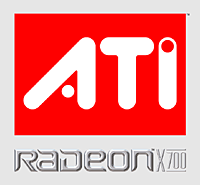 The
online gaming and hardware communities have a rather strong preoccupation with
performance, a focus that emphasizes the high-end of product markets. Thus attention
is predominantly given to the more expensive parts that attain the highest scores,
that push existing systems to new levels of performance. Boutique vendors such
as Falcon Northwest and Alienware cater almost exclusively to this market; larger
OEMs like Dell, however, do not necessarily share that perspective, and instead
give greater consideration to products that belong to the mainstream market.
ATI’s new Radeon X700 graphics chips are intended to address this section
of the market and today SimHQ will be looking at the X700 XT. While the X700
board range is priced from $149 to $249, the X700 XT 128 MB MSRPs for $199,
a price tag that targets the more casual buyer of discrete add-in boards.
The
online gaming and hardware communities have a rather strong preoccupation with
performance, a focus that emphasizes the high-end of product markets. Thus attention
is predominantly given to the more expensive parts that attain the highest scores,
that push existing systems to new levels of performance. Boutique vendors such
as Falcon Northwest and Alienware cater almost exclusively to this market; larger
OEMs like Dell, however, do not necessarily share that perspective, and instead
give greater consideration to products that belong to the mainstream market.
ATI’s new Radeon X700 graphics chips are intended to address this section
of the market and today SimHQ will be looking at the X700 XT. While the X700
board range is priced from $149 to $249, the X700 XT 128 MB MSRPs for $199,
a price tag that targets the more casual buyer of discrete add-in boards.
Based on the R420 architecture, the X700s (R410) are
120m transistor parts manufactured using TSMC’s 110nm process. Die size
plays a key role in manufacturing costs, and as chips designed for the mainstream
segment the X700s lowered their transistor count down below that of the faster
X800s primarily by reducing the number of pixel pipelines from 16 to 8. Likewise
the memory interface has also been shrunk from 256- to 128-bits, though ATI’s
specifications of using fast GDDR3 RAM for the XT boards somewhat ameliorates
the obvious impact the smaller interface has on memory bandwidth. A quick look
at the X700 board lineup reads as follows:
| |
X700
|
X700 Pro
|
X700 XT
|
X700 XT
|
| Pipelines |
8 pipes
|
8 pipes
|
8 pipes
|
8 pipes
|
| Clock speed |
400 MHz
|
420 MHz
|
475 MHz
|
475 pipes
|
| Pixel Fill-rate |
3.2 GP
|
3.4 GP
|
3.8 GP
|
3.8 GP
|
| On-board memory |
128 MB
|
256 MB
|
128 MB
|
256 MB
|
| Memory speed |
300 MHz
|
432 MHz
|
525 MHz
|
525 MHz
|
| Memory bandwidth |
9.6 GB
|
13.8 GB
|
16.8 GB
|
16.8 GB
|
| MSRP |
$149
|
$199
|
$199
|
$249
|
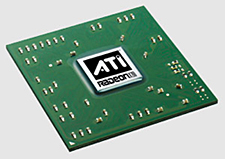
The X700 XTs ship with core clock speeds set very closely
to those of the X800 boards, giving them a greater pixel fill-rate than last
year’s high-end graphics cards. Worth noting is that while the X700s have
significantly lower fill-rates compared to the X800 boards, ATI has chosen to
retain the same vertex engine setup for the X700s as the faster parts. In the
past mainstream chips generally boasted two vertex shader units, and even last
year’s flagship 9700/9800 chips possessed only four vertex units, so the
inclusion of all six is certainly an interesting decision since one could’ve
reasonably expected to see this section of the architecture likewise halved.
Also noteworthy is that the X700 boards are PCI Express only products; ATI is
keen on addressing the mainstream market with these boards, which is already
orientating itself rather quickly to the new bus. SimHQ suspects this decision
could be a foreshadowing of things to come for future, next generation graphics
boards, even the high-end cards, though only time will tell if this suspicion
bears fruit. The review board ATI sent SimHQ is fairly small, barely 6.5 inches
long, and bears a thin, L-shaped copper cooler with fan; the board also doesn’t
require a power connector since its requirements can be supplied by the PCIe
slot itself.
X700 Architecture Overview
As previously mentioned, the X700 graphics chips are
based on the same architecture as the X800s and are thus identical in terms
of features supported and functionality as that of the faster parts. While the
X700 graphics chips have half the pixel pipelines they do still offer two shader
and one texture unit per pipe, the same as the X800s. The following is a brief
specifications list for the X700s:
- Smartshader HD
- support for DirectX 9.0 pixel and vertex shaders, multiple render targets
(MRTs), and OpenGL support for complete feature set via extensions.
- Smoothvision HD
- support for 2x/4x/6x programmable and temporal multisampling anti-aliasing
modes, adaptive anisotropic filtering modes, and lossless color compression.
- 3Dc - support for
normal map compression (4:1).
- Hyper Z HD - support
for hierarchical Z-buffer with early Z test, lossless Z-buffer compression,
and fast Z-buffer clear.
- Videoshader HD
- support for Real, DivX, and WMV9 formats, all-format DTV/HDTV decoding,
and adaptive per-pixel de-interlacing and frame rate conversion.
- Display Outputs
- dual integrated 400 Mhz DACs, integrated TV output up to 1024x768 resolution,
and YprPb component output for HDTV support.
A more comprehensive features list for and description
of the X700 architecture can be read in SimHQ’s Radeon X800 XT review here.
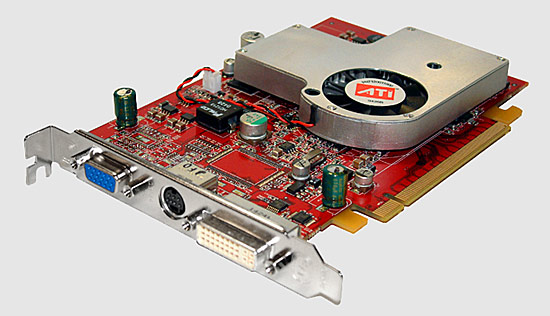
Test System Setup
- Intel Pentium 4 3.46 GHz Extreme Edition processor
- Intel D925XECV2 (925XE chipset, 1066 Mhz FSB) motherboard
- 1 GB (2x512 MB) Micron DDR2 533 Mhz memory
- ATI Radeon X700 XT and X800 XT PCI Express graphics
cards (Catalyst 4.11)
- Windows XP Professional (SP2)
- DirectX 9.0c
The benchmark suite used to evaluate this test system
is listed here.
Again, unless specified otherwise all games are configured to their highest
settings, and 32-bit color and trilinear texture filtering are the default baseline
during testing. Also, Windows XP is configured to have Automatic Update, System
Restore, and all unnecessary startup services disabled. Fraps 2.3.3 is used
to record performance scores unless otherwise noted, and care is taken to ensure
that ATI’s A.I. optimizations are disabled during testing.
Benchmark Scores
For comparison purposes a Radeon X800 XT is also included
to allow an analysis of how each title in the test suite is or isn’t affected
by the significant performance differences of the two boards. And with this
in mind, testing was conducted with in-game settings configured at higher, more
demanding levels.
Lock On: Modern Air
Combat was tested using the MiG-29 Intercept
demo. In-game settings were at their highest options, except for several features
such as water and heat bltr which were set to low and turned off. The demo was
run for three minutes.
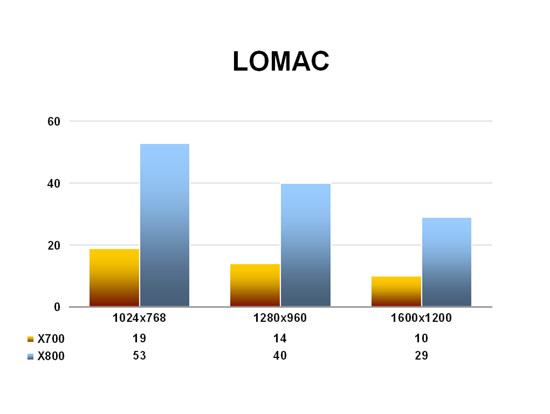
With LOMAC’s graphics set at high the game
is obviously unplayable at any of the resolutions, with the frame rate falling
to roughly a third of what the X800 XT scored. Fans of this particular title
shopping for a new graphics card at this price point will have to either spend
more money or dial quite a number of the in-game options down a few notches.
Microsoft’s Flight
Simulator 2004 was tested using SimHQ’s
in-house dusk flight over the city of Hong Kong, with an external camera view
set behind the plane. Frame rate recording is stopped once the plane lands.
MS: 2004 was configured with ultra high settings across its four hardware panels.
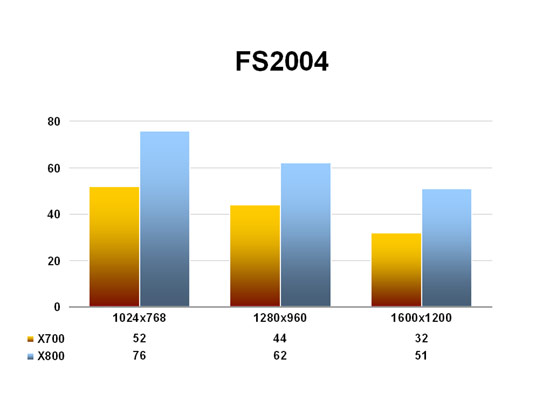
The X700 XT scaled well with the resolution changes
and remained surprisingly playable at even 1600x1200, with the frame rate staying
close to two-thirds that of the faster card.
IL-2: Forgotten Battles
- Aces Expansion Pack represents SimHQ’s
non-modern flight simulation test. Using OpenGL, the landscape option was set
to perfect and all other graphics options were at their highest settings. Testing
consisted of using the Black Death track. SimHQ plans to incorporate the latest
IL-2 release, Pacific Fighters, into our benchmark suite in the near future.
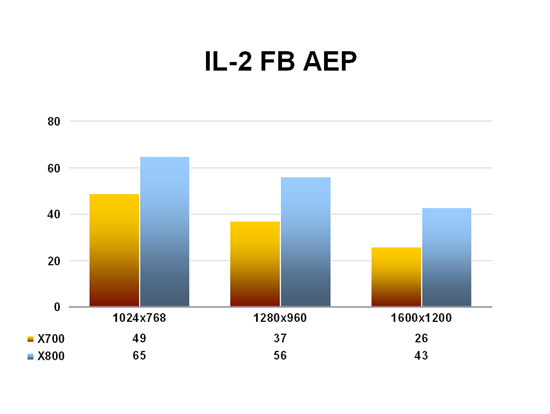
IL-2:FB-AEP is another title that turns in respectable
scores while running on this mainstream board, though the lower fill-rate of
the X700 board takes its toll at the higher resolutions, showing a sharper frame
rate drop than the X800 displayed. The game, however, might still be playable
for some even at the highest resolution tested.
Far Cry benchmark
numbers are generated by repeated playings of the Research map, which consists
of an good mix of beach, jungle, and interior settings found throughout the
game’s various levels. Fraps is used to record performance as the same
path is taken through the map during each test and all in-game options were
configured for their highest settings (water at ultra high).
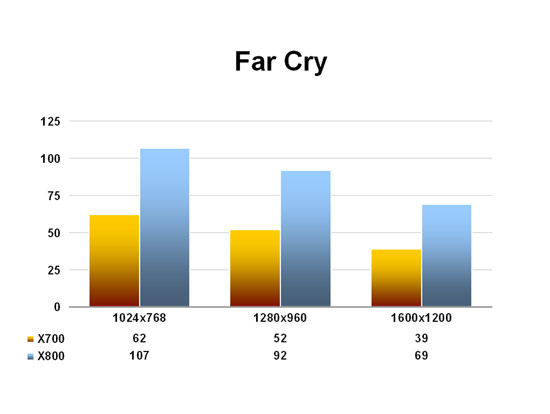
The X700 XT hung tough again, keeping the frame
rate at a playable number throughout testing. While the X800 XT scores considerably
higher its greater fill-rate and bandwidth doesn’t allow it to outperform
the slower card as much as one might expect.
Call of Duty
is the second title SimHQ uses testing OpenGL rather
than the D3D API. Scores were derived from the Dawnville demo using the in-game
timedemo utility to capture performance. The “com_maxfps” console
command was also used to lift the default frame rate cap of 85.
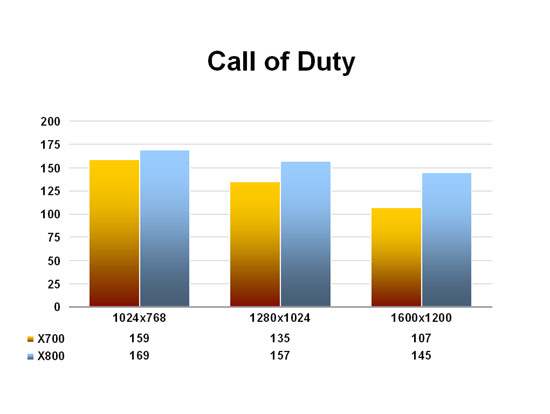
Games built upon the aging Quake 3 engine aren’t
much of a challenge to new hardware these days, even for mainstream budget cards,
and the X700 pulls triple digit frame rates even at 1600x1200. It obviously
begins hitting its fill-rate limits at the higher resolution as the frame rate
drops considerably lower than the X800’s score.
NASCAR Racing 2003 Season
was tested using SimHQ’s in-house replay,
which consists of a crowded Daytona track with the camera view set to Earnhardt’s
cockpit. All graphics options were placed at their highest settings.
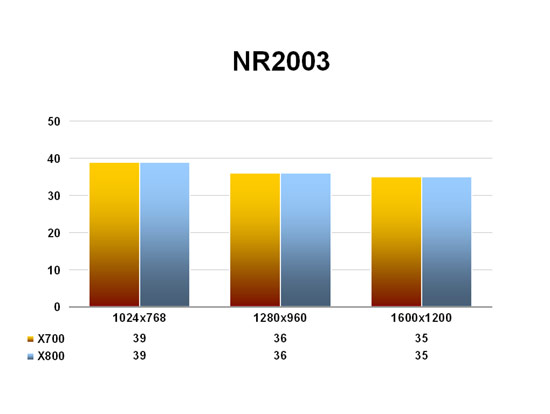
This particular title proves once again that its performance
is entirely dependent upon the speed of the CPU it’s running on. SimHQ
is looking to retire NR2003 from its benchmark suite in the near future and
replace it with SimBin's GTR.
Valve’s Video Stress
Test is a utility now included with the
new Source engine-based version of Counter-Strike. The Video Stress test itself
is a fly-by of a relatively small custom level and is designed to show off numerous
graphical effects rendered through the heavy use of various shaders.
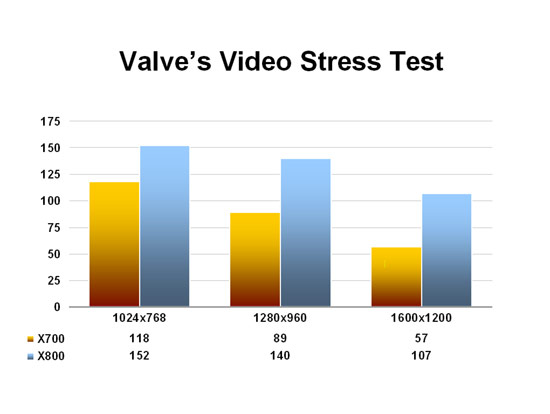
While the X800 loses roughly a third of its frame
rate as the resolutions were increased, the X700 drops by more than half. One
has to wonder if the 128 MB of on-board RAM was inadequate for the frame buffer
size and textures the test requires. Regardless, the card still managed a solid
frame rate of 57 at 1600x1200.
Image Quality
As a derivative of the
R420 architecture, the X700s also support programmable multisampling modes of
anti-aliasing. A sparse sampling pattern is defaulted to when the feature is
enabled via ATI’s driver panel, identical to that of the X800s. And temporal
AA, the changing of the sampling pattern used each frame, is also supported
by the X700s. Anti-aliasing performance is tested using IL-2: Forgotten Battles-Aces’
Black Death track at the resolution of 1024x768.
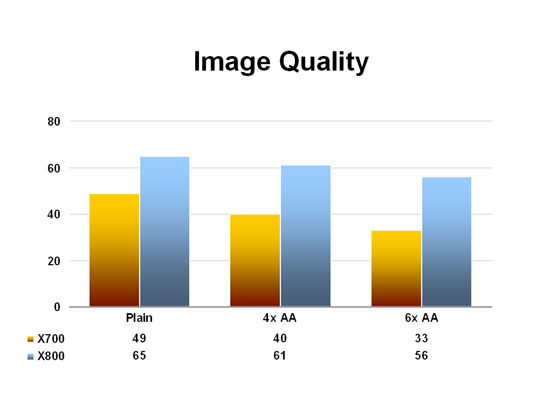
While the X800 loses less than 10% once 4x AA was enabled,
the X700 lost slightly over 20%, a result most likely caused by the memory bandwidth
difference between the two boards. This trend continues with 6x also, with the
slower board losing 30% of its performance, a much worse score than what the
X800 exhibited. Gamers interested in using anti-aliasing may need to bear in
mind the greatly reduced bandwidth mainstream cards such as the X700 ship with.
As explained in the X800 XT review, the ATI’s A.I.
option enables an adaptive filtering algorithm that examines the scene being
rendered and attempts to filter with a emphasis on performance. When set at
low A.I. enables all title-specific optimizations that ATI has built into the
Catalyst drivers, while at high the adaptive filtering is applied more aggressively.
Both A.I. and anisotropic filtering are tested below at 1024x768, again using
IL-2: Forgotten Battles-Aces’ Black Death track.
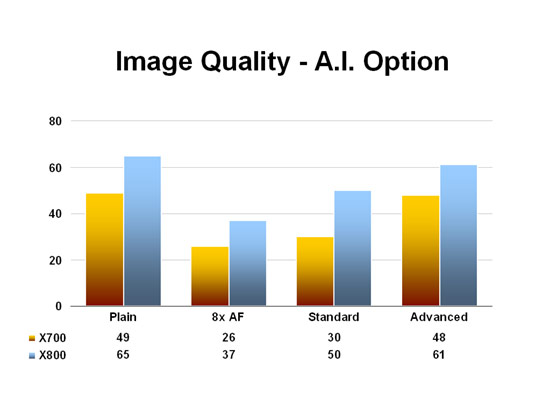
As usual IL-2: FB-Aces sees a tremendous frame
rate drop with anisotropic filtering, with the X700 losing almost 50% of its
performance. Enabling A.I. at its standard setting (formerly low), however,
lends a much higher boost for the X800 than the X700, a peculiar situation since
changing the setting to advanced (formerly high) brings the frame rate back
up consistent between the two boards.
Gallery
All screenshots were captured
at 1024x768 with 4x AA and 8x AF enabled using the licensed version of Fraps
2.3.3. Images are saved in the png format.
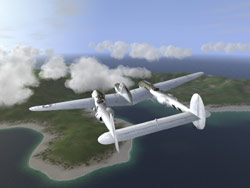 |
 |
P-38 from IL-2:FB - AEP
(760 kb) |
A-10 from LOMAC
(624 kb) |
Conclusion
Using the latest Catalyst
driver version, the X700 rendered every game thrown its way without issue and
offered image quality identical to that of the high-end X800. Yet as a PCI Express
only part, the X700 XT is clearly intended by ATI to appeal to OEMs seeking
a discrete add-in graphics board that is robust in its feature set and performance
since the new bus hasn’t had sufficient time to saturate the home market.
Moreover, SimHQ would be somewhat remiss if we failed to mention that the noise
level generated by the card’s fan is most likely to be unacceptable to
the typical home system builder, as its speed stepping is engaged almost immediately
the moment a game is launched; the X700 is inarguably the loudest graphics card
this reviewer has ever heard. ATI has perhaps been too aggressive with the clock
speeds for the X700 XTs, and it will be interesting to see if board partners
are able to improve the cooling solution for their offerings.
A recurring trend in the
graphics market is that of current mainstream cards giving performance equal
to, if not greater than, the previous year’s high-end offerings, and the
Radeon X700 XT certainly upholds that pattern. ATI has succeeded in essentially
retiring the 9700 and 9800s from last year with their X700 lineup, as these
new cards give all the features of the R420 architecture while boasting higher
fill- and vertex rates thanks to the high clock speeds of the graphics chips.
And for a board that comes with a suggested price of $199, less than half the
$450 price tag of the X800 XT, the X700 XT exhibited remarkably good frame rates
throughout most of SimHQ’s current test suite — so long as the prospective
buyer isn’t particularly keen on combining anti-aliasing or anisotropic
filtering and higher resolutions. Those looking to upgrade their aging graphics
cards from years gone by without the financial burden of a second home mortgage
should give the Radeon X700s consideration.
Copyright 2008, SimHQ.com. All Rights Reserved. Contact the webmaster.
 The
online gaming and hardware communities have a rather strong preoccupation with
performance, a focus that emphasizes the high-end of product markets. Thus attention
is predominantly given to the more expensive parts that attain the highest scores,
that push existing systems to new levels of performance. Boutique vendors such
as Falcon Northwest and Alienware cater almost exclusively to this market; larger
OEMs like Dell, however, do not necessarily share that perspective, and instead
give greater consideration to products that belong to the mainstream market.
ATI’s new Radeon X700 graphics chips are intended to address this section
of the market and today SimHQ will be looking at the X700 XT. While the X700
board range is priced from $149 to $249, the X700 XT 128 MB MSRPs for $199,
a price tag that targets the more casual buyer of discrete add-in boards.
The
online gaming and hardware communities have a rather strong preoccupation with
performance, a focus that emphasizes the high-end of product markets. Thus attention
is predominantly given to the more expensive parts that attain the highest scores,
that push existing systems to new levels of performance. Boutique vendors such
as Falcon Northwest and Alienware cater almost exclusively to this market; larger
OEMs like Dell, however, do not necessarily share that perspective, and instead
give greater consideration to products that belong to the mainstream market.
ATI’s new Radeon X700 graphics chips are intended to address this section
of the market and today SimHQ will be looking at the X700 XT. While the X700
board range is priced from $149 to $249, the X700 XT 128 MB MSRPs for $199,
a price tag that targets the more casual buyer of discrete add-in boards.











